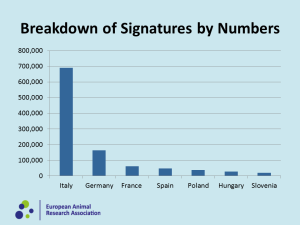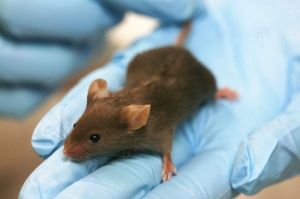I’m writing this post as a response to the Stop Vivisection European Citizens Initiative (ECI).
What is a European Citizens’ Initiative?
Easy questions first – The ECI
The European Citizens’ Initiative (ECI) was introduced with the Treaty of Lisbon, aimed at increasing direct democracy in the European Union. The initiative enables one million EU citizens, who are nationals of at least one quarter of the Member States, to call directly on the European Commission to propose a legal act in an area where the Member States have conferred powers onto the EU level.
-Wikipedia
It’s basically a petition. There’s a great piece over here at Speaking of Research. To summarise, the ECI was started in Italy, which is currently struggling with anti-science and anti-vivisectionist sentiments and has been picked up in a couple of other countries. It now has the required 1 million signatures it needs to be discussed by the EU parliament.
Here is an interesting graph on the breakdown of which EU countries the Stop Vivisection supporters come from:
European Animal Research Association, originally posted http://eara.eu/activists-turn-to-eu-to-ban-animal-research/
What is vivisection?
The Stop Vivisection website declaration says:
We urge the European Commission to abrogate directive 2010/63/EU on the protection of animals used for scientific purposes and to present a new proposal that does away with animal experimentation and instead makes compulsory the use – in biomedical and toxicological research – of data directly relevant for the human species.
-Stop Vivisection
So what is animal experimentation? Even experiments that are not on live animals may involve things derived from animals – some antibodies for example are derived from animal blood; cell culture utilises animal products (serum). So while it is an alternative to using live (or dead) animals, these techniques may require products derived from animals.
Various animal species are used for experimentation. Fruit flies, worms (C. elegans is a nematode), mosquitoes, Plasmodium (the amoeba that causes malaria), zebrafish, octopus, mice, rats, marmosets, ferrets, dogs, cats, rabbits, guinea pigs, frogs… this is by no means an exhaustive list.
What is the current legislation?
The ECI calls “to abrogate directive 2010/63/EU” which is the EU which regulates animal experimentation in the UK (and indeed the rest of the EU). The directive is described on the European Commission website it legislates for the protection of animals used for scientific purposes. It aims to limit animal testing and it dictates minimum standards of housing and care. It is based on the “Three R’s” of animal research with the eventual aim of ending all animal experiments. It applies to all vertebrates and invertebrates likely to feel pain (octopus). It also prohibits experimental work on great apes. All animal procedures have to be approved before they are performed. Procedures must only be performed by approved personel.
Fundamentally, the legislation is based on the Three R’s:
- it allows animal use only where no alternative methods exists – Replacement.
- the number of animals used must be minimised, but without compromising the objectives of the project – Reduction.
- methods must be refined in order to minimise suffering and numbers of animals used, it includes housing methods as well as procedural ones – Refinement.
Animal research facilities have to conform to this legislation. In the UK this is enforced by the Home Office.
In the EU it is currently illegal to test cosmetics or their ingredients on animals.
Why use animal models?
Animals are used in basic research and for developing medical treatments. Understanding how biological systems, pathways, organs, genes, or proteins work normally helps scientists understand what happens when these go wrong and how they can be fixed. Some of these can be modelled without having to use animals. Many of these cannot be modelled because the systems are not understood. Contrary to what the Stop Vivisection campaign state, the alternatives are not currently sufficient to replace all animal research. The myths of the Stop Vivisection campaign are addressed point by point here.
Take the brain as an example. There are an average of 86 billion brain cells in the human brain. These have various functions such as light detection, scent detection, they can form circuits that have a single function such as balance, and some act like wires transmitting information from one area to another. These neurons form 100 – 1000 trillion connections. The closest attempt at modelling the human brain used a super-computer to model 1 second of activity and took 40 minutes to run. We are a long way from fully understanding conditions such as schizophrenia, depression and Alzheimer’s.
The issues with doing basic research in humans is that an observer needs to see what is happening in milliseconds with micrometre resolution. These techniques do not exist. Magnetic Resonance Imaging (MRI) uses blood flow as an index for neuronal activity, but it has limitations. Real time MRI has a temporal resolution of 20 – 30 milliseconds and a spatial resolution of 1.5 – 2 mm (Wikipedia), this is not good enough to look at the activity of a single neuron.
The brain is just one organ. The organ systems vary in the way they work. To further complicate matters, they also interact with each other.
Medicinal research also utilises animals. It is possible to observe the effects of a drug on cells in a test tube, indeed many chemicals are screened with techniques that don’t use animals and use human cells instead. There is a huge difference between the effects of a drug on a single cell compared to the body as a whole. Take alcohol, for example. On some neurons it inhibits activity, but these neurons are in different parts of the brain with different functions. The actions of alcohol on a single cell don’t explain why, for example, you need to pee more when you’ve been drinking (a process which involves the brain and the kidneys). That is only one of the things that alcohol does to the body.
Actually, scientists would rather not use animals
The current legislation stipulates that if there is an alternative to using animals, the alternative methods must be used. Keeping animals housed and fed is pretty expensive – the cell-based drug screening methods mentioned above save the pharmaceuticals industry a lot of money. The right alternatives would provide more accurate data than that generated using animals. And researchers working on animals would just rather not use animals if it was possible. The sooner the alternatives are developed the better for everyone. But until then, animal experiments are a necessary evil.


